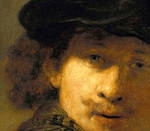
"The Judgement of Solomon"
This large-format canvas is a superb example of Italian Baroque painting. In this strongly narrative scene, Giordano creates enormous tension through the pyramidal arrangement of the figures, culminating in the child hanging upside down, held by the ankle. The realistic treatment of the faces is reminiscent of the work of the Spanish painter Ribera, under whom Giordano studied as a young man. At the same time, the play of light and shadow recalls Caravaggio’s use of chiaroscuro, imitated by the contemporary Neapolitan school. Luca Giordano worked for several years in Spain, where he produced a number of frescoes; the most outstanding of those surviving in Madrid is the dome of the Casón del Buen Retiro.
Luca Giordano (18 October 1634 – 3 January 1705) was an Italian late-Baroque painter and printmaker in etching. Fluent and decorative, he worked successfully in Naples, Rome, Florence, and Venice, before spending a decade in Spain. developed an elaborate Baroque style fusing Venetian and Roman influences. He is also noted for his lively and showy use of color. In 1682–1683 Giordano painted various fresco series in Florence, including one in the dome of the Corsini Chapel of Santa Maria del Carmine, Florence. In the large block occupied by the former Medici palace, he painted the ceiling of the Biblioteca Riccardiana (Allegory of Divine Wisdom) and the long gallery of the Palazzo Medici-Riccardi.
While in Spain, he painted major decorative schemes at the Buen Retiro Palace, El Escorial, the sacristry of Toledo Cathedral and the Royal Palace of Aranjuez. The Allegory of the Golden Fleece, a c. 1694 fresco on the ceiling of the Casón del Buen Retiro is one of the possible reasons given for the building having survived when most of the other Buen Retiro palace complex buildings were demolished in the nineteenth century, now it's an annex of the Prado Museum Complex that holds a library for researchers. He also painted part of the frescoes at the Church of Saint Anthony of the Germans and many pictures for the court, private patrons and churches.
His later works done in Naples were executed in a lighter, less rhetorical style, these late works, prefiguring Rococo, proved influential throughout the eighteenth century, and were admired by Fragonard.
He left many works in Rome, and far more in Naples. Of the latter, his Christ expelling the Traders from the Temple in the church of the Padri Girolamini, a colossal work, full of expressive "lazzaroni" or beggars from Naples; also the frescoes of the Triumph of Judith at San Martino , and those in the Tesoro della Certosa, including the subject of Moses and the Brazen Serpent; and the cupola paintings in the Church of Santa Brigida